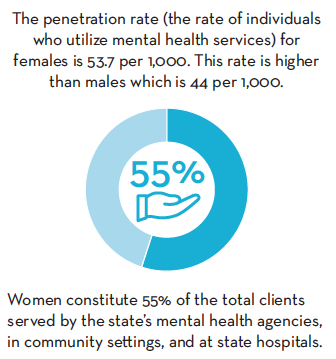
Excessive alcohol use can result in various harms (such as motor vehicle injuries, violence, heart disease, cancer, alcohol poisoning, and poor birth outcomes). For women, having 4+ drinks on one occasion is considered binge drinking. Any drinking by pregnant women or people under the age of 21, or women having 8+ drinks in a week, is classified as heavy drinking (source).
In the United States, as of 2019, the rate of overdose deaths among females is 14.4 per 100,000 (source). The prevalence rate of pregnant women with opioid use disorder at labor and delivery has quadrupled from 1999 to 2014, from 1.5 per 1,000 delivery hospitalizations to 6.5 in 2014 (source).
Extra source: The MN Center for Rural Policy and Development produced this report with additional information on the opioid crisis.
The 2SLGBTQIA+ Community and Substance Use Disorder
There are a variety of unique factors that influence the use of substances in the Two-Spirit, Lesbian, Gay, Bisexual, Transgender, Intersex, Asexual, and other non-heterosexual and gender-expansive identities (2SLGBTQIA+) community including, systemic homophobia and racism and interpersonal issues such as violence. To learn more, read the 2017 Epidemiological Profile of Substance Use in MN’s LGBTQ Community. This is a comprehensive profile developed on behalf of the MN State Epidemiological Outcomes Workgroup, curated to help the state and its communities determine different prevention needs. It summarizes the different demographics of the 2SLGBTQIA+ population and sheds some light surrounding alcohol, tobacco, and drug use among MN’s LGBTQ+ community compared to the heterosexual and cisgender community. Additionally, there are data on mental health and risk/protective factors.
What is an ACE? How is an ACE Scored?

An Adverse Childhood Experience (ACE) is a traumatic experience in a person’s life that occurs before the age of 18 that the person recalls as an adult. We are including ACEs in this report because they are associated with poor physical and mental health, chronic disease, lower educational achievement, lower economic success, and impaired social success in adulthood. ACEs are strongly associated with indicators of mental health issues later in life. The higher the ACE score, the more likely adults are to report depression or anxiety in adulthood. According to MDH’s ACEs in MN, the “ACE score measures cumulative exposure to particular adverse childhood conditions. Exposure to any single ACE condition is counted as one point. Points are then totaled for a final ACE score. It is important to note that the ACE score does not capture the frequency or severity of any given ACE in a person’s life, focusing instead on the number of ACE categories experienced. In addition, the ACE categories used in the ACE study reflect only a select list of experiences” (page 14).

Sources for table (above):
- 57% reported experiencing 1+ ACE in childhood
- 24% reported experiencing 3+ ACEs in childhood
- 13% ages 18-65 are current smokers
- 10% smoked while pregnant
- 55% 18+ reported alcohol use
- 22% ages 18-44 years were more likely to say they binge drink than those 44+ years (9%)
- 12% of pregnant women indicated that they drank alcohol in the last month
- <5% of pregnant women said they binge drank in the past month
- 2.5% reported any use of prescription drugs not prescribed for them by their doctor within the past 12 months
- 17% reported using illicit drugs or misusing prescription drugs
- 4% reported misusing opioids
- 2.5% reported misusing prescription pain relievers
Major Depression
Major depression is ranked the most impactful condition among commercially-insured women in MN, accounting for 19.1% of adverse health conditions (source).
Alcohol Use Disorder
Alcohol use disorder makes up 3% of adverse health conditions, and substance use disorder makes up an additional 3% among this population. These numbers are likely incomplete due to not measuring the uninsured population of Minnesotans, estimated to be approximately 349,000 people as of 2017 (source).